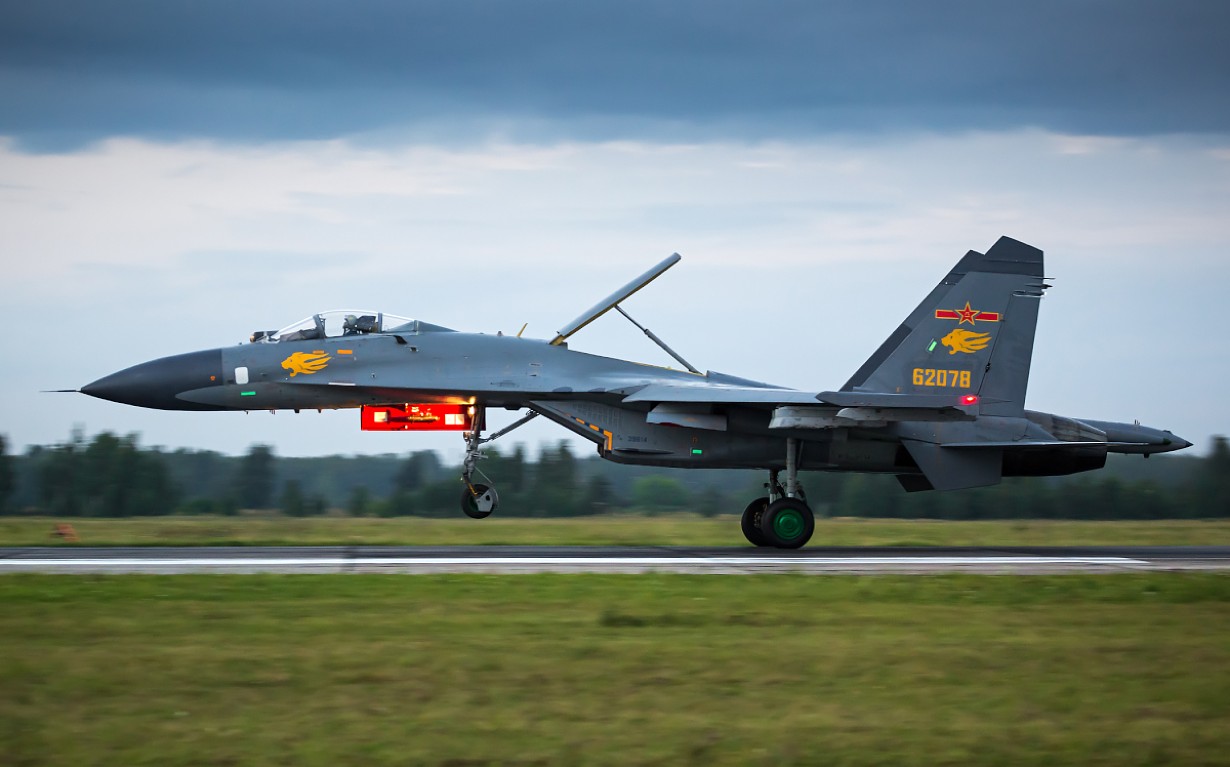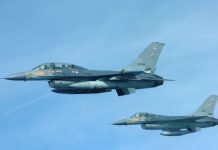China’s Liaoning Carrier Strike Group, which entered the Western Pacific earlier this month, has been hogging the media limelight. However, another PLAN Carrier Shandong has been conducting mock drills in the South China Sea, likely stimulating attacks on US Naval targets in the disputed region.
On December 21, the same day that a Chinese J-11 fighter jet intercepted a US Air Force RC-135 reconnaissance plane in what the Pentagon called an “unsafe maneuver,” the Chinese Navy practiced an attack on a US Navy task group in the South China Sea. The US released a video of the dangerous intercept only on November 30.
New reports and satellite images have revealed that the Chinese PLA Navy carrier Shandong has been conducting drills in the South China Sea with several unknown fighter jets, refueling aircraft, and bombers.
Independent OSINT Analyst Damien Symon revealed in a tweet that while the Chinese Liaoning carrier was conducting drills near Japan, the People’s Liberation Army Navy Aircraft Carrier Shandong was seen operating in the South China Sea in the latest satellite imagery.
While #China's Liaoning carrier is running drills near Japan, Shandong (CV-17), The People's Liberation Army Navy Aircraft Carrier is seen operating in the South China Sea on recent imagery pic.twitter.com/QUSrOtfKJY
— Damien Symon (@detresfa_) December 24, 2022
Besides, an unnamed Asian country official told the Financial Times, “As part of that exercise, a strike group led by the Shandong simulated attacks on a US Navy formation.” The unsafe interception of the RC-135 aircraft by the J-11 allegedly happened during these mock drills.
It is pertinent to note that while Chinese media has tremendously publicized the military drills conducted around Taiwan and its joint maneuvers with the Russian military in the region, it has not divulged any details on the South China Sea mock drills. A recent report in state media also revealed that the PLAN Liaoning carrier sailed close to the island territory of Guam, a significant frontline military outpost of the US in the Pacific.
However, new reports indicate considerable air and naval action in the South China Sea, including refueling sorties above the Bashi Channel. This strategically important strait connects Taiwan’s southern point to the northern tip of the Philippine island of Luzon.

In August this year, a photo released by the People’s Liberation Army Air Force (PLAAF) days after its live-fire exercises around Taiwan showed the J-20 ‘Mighty Dragon’ stealth fighter and the J-16 fighter-bomber receiving mid-air refueling from its indigenous YU-20 tanker aircraft. While unconfirmed, this could be the same aircraft refueling unknown PLAAF fighter jets.
China claims nearly the entire South China Sea and regularly conducts military drills in the region. For instance, after US House Speaker Nancy Pelosi visited Taiwan, the PLAN conducted exercises in the South China Sea beside the Taiwan Strait without specifying if they were interrelated.
However, not every day, the PLA stimulates attacks on US formations in the region. It is even more unusual for a spy plane to run the risk of collision while trying to collect critical intelligence from these drills.
Did Shooting US Targets In The SCS Lead To Dangerous Interception?
The fact that the J-11 intercepted the US spy plane during the same exercise may point to the fact that the US aircraft was flying over the region to monitor the PLA drills, which are also not unusual for militaries. Besides, US reconnaissance aircraft regularly fly patrols in international airspace over the South China Sea.
The US military sent three P-8A maritime patrol aircraft, one RC-135V surveillance aircraft, and one E-3G airborne early warning and control aircraft to the South China Sea and south of the Taiwan Strait on December 21, according to the SCS Probing Initiative. It’s possible that the RC-135V in question was the one the J-11 intercepted.
The SCS Probing Initiative, based in Beijing and sponsored by Peking University, has asserted that “The US military conducts three to five sorties to the South China Sea every day.” However, the timing of these sorties coinciding with PLA military drills could be far from an unusual coincidence.
Besides, these drills were conducted simultaneously with the Liaoning’s maneuvers in the West Pacific. China has fiercely opposed the US decision to finance weapons purchases for Taiwan. It may also be noteworthy that the Bashi Channel, over which refueling operations took place, is a significant passage from the South China Sea in the broader Pacific to the east.

However, this may not be the first time that China is stimulating attacks on US naval assets. In September this year, Taiwan’s Ministry of National Defense (MND) said that China was simulating attacks on US Navy ships and was aiming to prevent foreign forces from coming to Taiwan’s aid in the event of a war.
More recently, H-6 bombers flew over the Miyako Strait between the main island of Okinawa and Miyakojima and entered the Pacific Ocean to reach Okidatio Island. EurAsian Time noted that the H-6 bombers simulated firing the air-launched anti-ship cruise missiles (ASCM) against enemy naval flotillas, in this case, the United States Navy (USN).
統合幕僚監部12/19発表 中国機の動向について
12/19,午後、中国軍用機H-6爆撃機(H-6J或いはH-6KGか?)2機が東シナ海方面より飛来。宮古海峡を通過し太平洋へ至り、沖大東島南東沖で反転。宮古海峡から東シナ海方面へ
位置的に遼寧航母編隊との演習等と想像は出来る。4枚目が12/17,11時の遼寧の位置 pic.twitter.com/D3LcFyt4kS— miki@横鎮 (@09120309) December 19, 2022
China has become more insistent that the goal of its military exercises is to prevent any “foreign interference” in a potential invasion of Taiwan. The US-Taiwan alliance to thwart China may have contributed to the PLAN’s stimulation of strikes against US Naval sites in the region.
The US has further bolstered its presence in the South China Sea, significantly strengthening cooperation with ASEAN allies. For perspective, the Philippine ambassador to the United States, Jose Manuel Romualdez, stated that his country would allow US forces to use its military installations in a conflict with Taiwan if it was crucial for Manila’s security.
On the other hand, Indonesia is another crucial ally of the United States, and the two partners conducted extensive military drills in August. The United States has not shied away from sending its warships attached to its Seventh fleet for Freedom of Navigation Operations (FONOPs) in the South China Sea, irking Beijing.
In fact, in 2020, two Nimitz class aircraft carriers, the USS Nimitz and USS Ronald Reagan, took part in the first dual-carrier exercise held in the disputed region over six years.
Against this backdrop and amid prevailing tensions in the wider Indo-Pacific, China’s mock drills aimed at obliterating US Naval formations could be seen as preparing for an unforeseen contingency and a show of power.
In addition, two carrier groups exercising simultaneously in the backyard and far away from home is a significant military capability that the US would have keenly watched.
- Contact the author at sakshi.tiwari9555 (at) gmail.com
- Follow EurAsian Times on Google News




